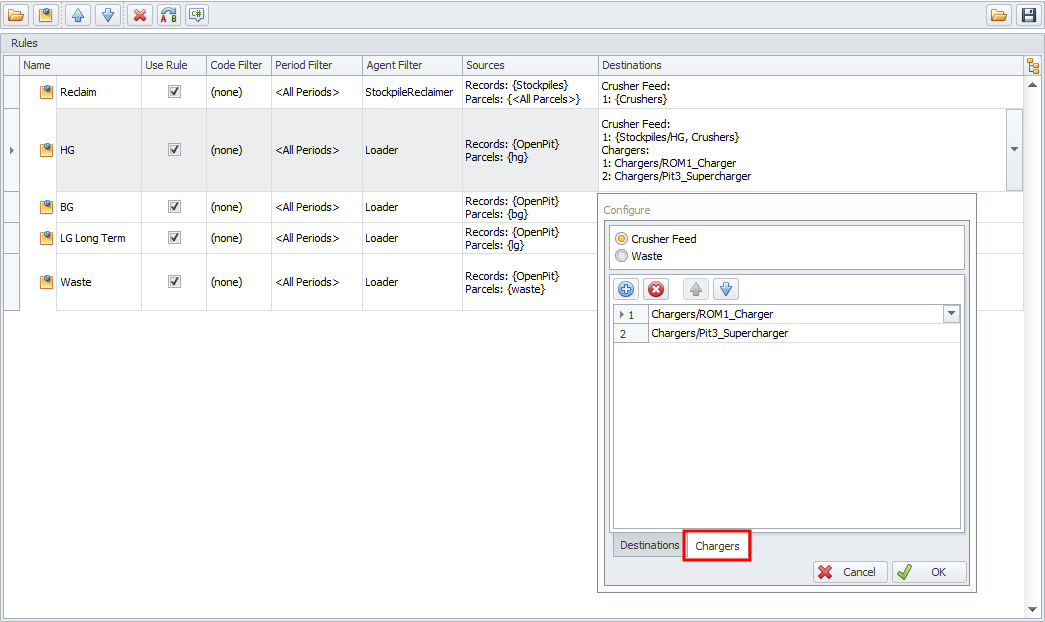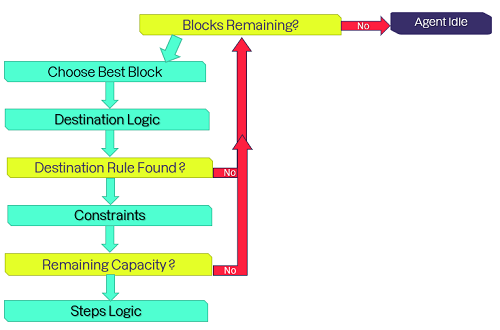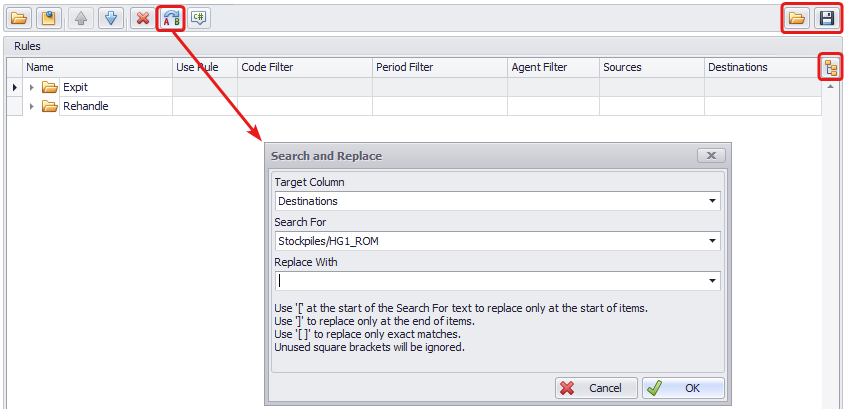Destination Logic
Destination Logic describes the resting place of material at the end of the period.
Once an Agent picks a block from the ranked blocks list, it needs to put it somewhere as per the Destination Logic, where for each scheduling period we are telling the software the final resting place of material if that block is picked.

Destination Logic example overview
Destination Rules Filters
Each rule lists the destinations for transactions that match its filter criteria:
Name
|
Description |
Note |
|---|---|
|
Give each rule a unique name, and group in folders. |
Avoid using commas in the Destination Rule name, because when exporting future reports to CSV, the commas result in misalignment of the columns. |
Use Rule
-
If the rule is available to be used, leave the box checked.
-
Untick the check box to disable the rule.
Code Filters
|
Description |
Note |
|---|---|
|
May differentiate destinations by some custom logic. |
Custom logic to differentiate destinations. For more details and a fully worked example, see: Code Filters. |
Period Filters
|
Description |
Note |
|---|---|
|
May differentiate pre- and post- plant commissioning. |
|
Agent Filters
|
Description |
Note |
|---|---|
|
May differentiate autonomous and crewed tipheads. |
StockpileReclaimer is a default Agent created by the software to reclaim from Stockpiles to feed the Crusher. It doesn’t work in a pit and should be unticked from the list of Expit Agents, and used for Stockpiles Rehandle only. The StockpileReclaimer as an Agent does not have a capacity. The rate of material movement is based on the Fleet assigned to the Reclaimer in the Steps Logic. |
Destination Logic (Top)
Source and Parcel Filters
If you need to prioritise direct feed to the Crusher over the Stockpiles reclaim in the Trucks Constraint mode, in the Destination rules, you should have two lines for the destination where the Crusher is priority 1 and Stockpile(s) are priority number 2.
If you put them on the same line, then the optimization engine will send it to the destination which is closer or faster to get to.

If you are using Product Optimisation mode, you can only keep Crusher Feed rules on the same line, and if the stockpiles are actually a closer haul (which is usually the case) then ensure that you have a cash flow on the Crusher to incentivise the direct tip especially if the Crusher is not receiving enough material in a period (you should put a cash flow on the Crusher in any case).

Chargers
|
Description |
Note |
|---|---|
|
If a model includes electric trucks, a column to limit routes to use specific chargers is available. |
This logic is used to prevent trucks from driving a long distance across the mine site to charge. If all chargers are set to constrain by kWh and the schedule requires more kWh than are available, chargers will be used over capacity to honor the schedule rather than constraining tonnages. Charger Capacity is consumed based on the order of the chargers selected in the list. Once charger capacity is consumed, trucks will continue to run and charging will ‘overflow’ to the closest charger in the list. |


Destination Logic (Top)
Notes & Recommendations
-
It there is no Destination Logic rule that covers a transaction, that Source to Destination movement won’t be able to take place.
-
To make it easier to manage the material flows and troubleshoot in case of scheduling errors, it is recommended to use folders for each group of movements with sensible names to follow the Destination Logic Rules.
-
Create an overarching folder for the Expit movements for each pit,
-
Create a folder for the Stockpiles reclaim to each destination.
-
-
Use Setup > Reserve Database > Parcel Subsets to specify applicable source parcels .
When an Agent generates a new schedule transaction, it reads through the Destination Logic list from top to bottom and applies the first rule that satisfies all filters. This means that if two rules have overlapping conditions, only the first rule will ever execute for that set of conditions.
Overlapping Rules
Advanced users may occasionally create "nested" destination rules. This means a list of two or three rules with successively broader conditions, so that if the first condition is missed, then the second condition is evaluated, and so on.

Note that each nested rule must contain ALL destinations for the nominated sources. You cannot spread the destinations across multiple rules, since only one rule is evaluated at a time.
Finding Destination

The Agent selects the highest ranked block and checks for available Destinations. If a block fails, it is removed from that Agent's ranked block list (another Agent may still try to mine it though).
Once the Agent has found the Destination Rule for available Destinations, it checks Constraints for available movement.
For more details see: Agents and Schedule Logic Overview
Destination Logic (Top)
Navigation
Creating a rule
-
Click theblue plus icon located in the toolbar to add a new rule.
-
Give the new rule a meaningful name.
-
Configure the rule as per the table definitions above.
-
Place rule into the relevant folder.
Tools
-
Rules can be imported and exported from projects using the floppy disk and folder buttons located in the toolbar.
-
Collapse or expand all folders using Expand/Collapse icon.
-
Use Search and Replace tool to find and replace items. Select items from the lists and read the tips provided.

Destination Logic Step tools
Copying a rule
-
Hold down the <CTRL> key.
-
Click and drag on the clipboard icon of that rule.
-
Drag and hold the cursor over another folder or icon where the new rule will sit. A blue arrow shows where the rule will be inserted.
-
Release the mouse to drop the new rule.

Copying LG rule
Destination Logic (Top)
